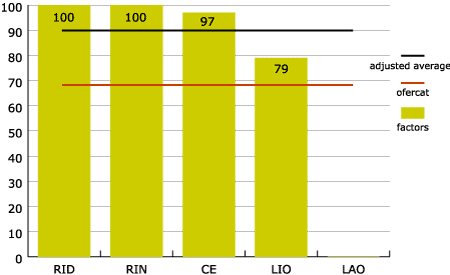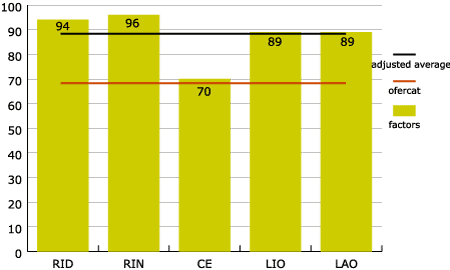
| The Local application of Ofercat to the city of Tarragona, by Rosa Ibarz and Enric Garriga | ||||
| CONTINUA |
The Education subsector includes all levels, from the kindergartens to higher and adult education, both public and private. In this section, where the Autonomous government of Catalonia has all the competencies —in some cases shared with the local councils— the written signs and labels are virtually 100%. On the question of Oral identification [LOI], in this case the observations were not based telephone calls —as in the other ambits— but rather on the language in which classes were given, according to the data supplied by the Education Department, Rovira i Virgili University and the centres for adult education. The language of teaching at secondary level, higher or tertiary level and in adult education are the reason for this indicator being a little lower than others [79%], although still quite high. Figure 10. Education
The Health subsector includes both the public and the private, and while the Autonomous administration has full powers here, the mobility of the staff and the proliferation of private clinics, provides an explanation for the fact that while the signs and labels index scores 94% for identifying notices [RID] and 96% for Informational notices [RIN], written communications [WRC] reach only 70% and oral language scores 89%. Figure 11. Health
L’Ofercat allows us to obtain specific data and determine specific objectives relating to the sociolinguistic situation, which can then be used to programme actions to further language normalisation in the light of the existing situation and giving priority to the most deficient sectors. When we compare the Tarragona results with those of the other areas where Ofercat has been used we find an intermediate situation, less Catalan than Tremp and Manresa, slightly more than Lloret de Mar and the Barcelona Old City (Ciutat Vella) and quite considerably more than the Barcelona suburb of Santa Coloma de Gramenet. If we analyse the results by sectors, we will see that the Tarragona results are noticeably less than those of Manresa and Tremp in two specific sectors: Public administration and Economy, and slightly so in the realm of Society and Leisure. Where the Public Administration factor is concerned, the results here that bring down the mean index score are Central Government and the Courts and court offices which, given that Tarragona is the Provincial capital, are present in force. In contrast, the rest of the settlements where Ofercat has been applied (with the exception of Barcelona's Ciutat Vella), the predominant administration is local government, while the other levels of administration are scarcely present or not present at all. Given the results of the study, now is the time to take advantage of them, and use them as a guide for future actions and future campaigns to increase normalisation in the municipal area of Tarragona. The work of the Centre for Language Normalisation of Tarragona (CNLT) will need to orientate its work over the upcoming years to correcting the shortfalls and weak points that the study has revealed. Of course the staff need be aware of the areas which are strictly their area of competence, and the areas which are the competence of other bodies working to the same end. By sectors, Local administration is the only level of government at which the Consortium for Language Normalisation (CPNL) has powers, and the results of the study show very clearly the work done since the CPNL was set up, in 1989, with an average of 96%, indicating that it is a sector that is completely language normalised. Regional government (i.e. of the Autonomous region of Catalonia) scores 98% and has its own network of language normalisation, so that the CPNL has no need to intervene. As for the other two administrative levels, the State (central government) and Justice (the law courts) with 52% and 41%, respectively), we see here that there is a clear need to intervene, although the sectors lie outside CNLT's area of operation. The Economy and Society and leisure sectors are those where the CPNL can intervene, and, given the results they register (66% and 73% mean score, respectively), it is evident that action by the CNLT over the coming years has to concentrate, above all on the Economy sector, which is slightly below the average for Tarragona (68%). In fact, in the fourteen years of CPNL's existence, the work carried out by the area of Dinamització i Assessorament (Vitalisation and consultancy) has aimed efforts mainly at these two areas and we imagine that without those efforts the indices in these two sectors would be lower. But there is still work to do, and it would be good if in the future second observation, the score obtained by Economy were to reach at least the overall mean level for the city. Of the three remaining sectors or subsectors, the Media, Education and Health, the CNLT can intervene in the first, but only where the companies in question are local and, in this case it does intervene actively. But it can do little to influence the linguistic decisions of other companies where they have opted for one languge or the other. The other two subsectors achieve indices of 90% and 89%, respectively, so that they are not priority areas for intervention. Rosa
Ibarz Meler Enric
Garriga Martí |

